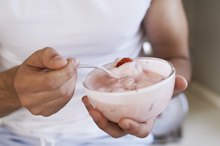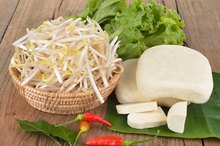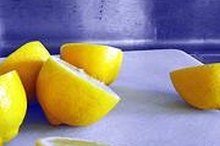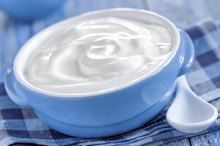Is There a Link Between Yeast Infections & Kidney Stones?
Kidney stones can be an extremely painful condition, often requiring surgery. In recent years there has been growing awareness of the debilitating set of symptoms associated with the microbe candida albicans, which causes yeast infections ranging from thrush to far more serious disorders. Many experts now suggest that there may actually be a link between candida albicans and the development of some common types of kidney stone 3.
Candida Albicans
Candida albicans is a yeast found commonly in the gastro-intestinal tract 1. In a healthy subject it may cause no harm, but in subjects with low immunity or a compromised digestive system it has been shown to proliferate and cause many health problems. Studies have shown that a deficit of "good" bacteria in the stomach, as is often caused by a course of antibiotics, may allow candida albicans yeast to proliferate and negatively affect health.
- Candida albicans is a yeast found commonly in the gastro-intestinal tract 1.
- Studies have shown that a deficit of "good" bacteria in the stomach, as is often caused by a course of antibiotics, may allow candida albicans yeast to proliferate and negatively affect health.
Kidney Stones
Best Probiotics for Treating Candida
Learn More
The sole function of the kidneys is to remove waste from the blood. Waste is transferred to the bladder to be excreted as urine. However, certain waste products may crystallize within the kidneys, and eventually form painful kidney stones. Most kidney stones are primarily composed of calcium compounds, particularly calcium oxalates. Oxalates are naturally occurring compounds that are found in many different foods, mostly fruit and vegetables, although in low levels. Candida albicans as well as other yeasts and fungi are known to be sources of oxalates 1.
- The sole function of the kidneys is to remove waste from the blood.
- Candida albicans as well as other yeasts and fungi are known to be sources of oxalates 1.
Oxalates
Since oxalates occur naturally in food it is difficult to avoid their consumption, but there is some evidence to suggest that candida albicans overgrowth increases the presence of oxalates. The naturopathic physician Tracy Tranchitella suggests that not only is candida albicans a direct source of oxalates, but also that a lack of normal "good" digestive bacteria—caused by candida overgrowth—can exacerbate the absorption and effect of oxalates.
Low Immunity
Foods to Eat When You Have Urinary Tract Infection
Learn More
There is additional evidence that oxalates inhibit the immune system. When this happens, the body is less able to defend itself against pathogens such as candida albicans. Indirectly this may cause the proliferation of candida yeast, which in turn increases the levels of stone-forming oxalates. Clinical studies have found some kidney and bladder stones to be infected with candida yeasts, precipitated with oxalate crystals and invading the surrounding areas.
- There is additional evidence that oxalates inhibit the immune system.
Evidence
There is compelling evidence for a connection between yeast infections and calcium oxalate kidney stones 2. Oxalate levels are increased by the presence of candida, and in turn candida overgrowth is stimulated by increased oxalate activity. However, while research does show a vicious circle connecting the two disorders in some cases, there is no evidence to suggest that the two disorders always co-exist.
Related Articles
References
- "International Journal of Oral and Maxillofacial Surgery"; Candida Albicans: a review ... ; McCullough et al; April 1996
- "The New England Journal of Medicine"; A Prospective Study of Dietary Calcium and Other Nutrients and the Risk of Symptomatic Kidney Stones; Curhan et al; March 1993
- "Urology": Detection by light microscopy of candida in thin sections of bladder stone; Takeuchi et al; Dec 1989
- Spampinato C, Leonardi D. Candida infections, causes, targets, and resistance mechanisms: traditional and alternative antifungal agents. Biomed Res Int. 2013;2013:204237. doi:10.1155%2F2013%2F204237
- Cunningham E. Is there a diet for "yeast allergy"?. J Acad Nutr Diet. 2013;113(3):484. doi:10.1016/j.jand.2013.01.013
- Fan S, Liu X, Wu C, Xu L, Li J. Vaginal nystatin versus oral fluconazole for the treatment for recurrent vulvovaginal candidiasis. Mycopathologia. 2015;179(1-2):95-101. doi:10.1007/s11046-014-9827-4
- Crook, WG. The Yeast Connection: A Medical Breakthrough. Jackson, Tenn., Professional Books, 1983.
- Dismukes WE, Wade JS, Lee JY, et al. A Randomized, Double-Blind Trial of Nystatin Therapy for the Candidiasis Hypersensitivity Syndrome. N Engl J Med. (1990) 323:1717-1723.
- Martin, Jeanne Marie and Rona, Zoltan P. The Complete Candida Yeast Guidebook. Rocklin, California:Prima Books, 1996.
- Santelmann H, Laerum E, Roennevig J, et al. Effectiveness of Nystatin in Polysymptomatic Patients. A Randomized, Double-Blind Trial With Nystatin Versus Placebo in General Practice. Fam Pract. (2001) 18:258–265.
Writer Bio
Eve Roberts has written and published professionally since 1998. She has a PhD in humanities and has published articles in magazines, books and journals. She has worked in the health food and education sectors.









